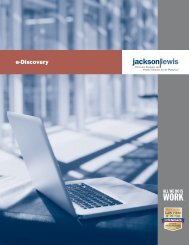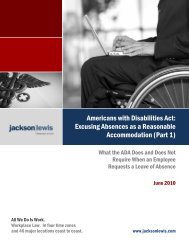Wage and Hour Compliance - Jackson Lewis
Wage and Hour Compliance - Jackson Lewis
Wage and Hour Compliance - Jackson Lewis
You also want an ePaper? Increase the reach of your titles
YUMPU automatically turns print PDFs into web optimized ePapers that Google loves.
The final regulations contain extensive provisions<br />
describing the required content for a COBRA election<br />
notice. The election notice should contain all of the<br />
information individuals need to decide whether to<br />
elect COBRA coverage. For example, the election<br />
notice must describe:<br />
• the particular Qualifying Event <strong>and</strong> the name or<br />
status of Qualified Beneficiaries eligible to elect<br />
COBRA coverage;<br />
• the date coverage will terminate (or has terminated)<br />
in the absence of an election;<br />
•premium payment requirements, including the<br />
due dates for payments <strong>and</strong> the consequences<br />
of non-payment;<br />
• the procedures for electing COBRA <strong>and</strong> the<br />
consequences of failing to elect COBRA;<br />
•how COBRA coverage could be extended due to<br />
disability or a second qualifying event; <strong>and</strong><br />
• the name of the plan <strong>and</strong> contact information for<br />
the person responsible for COBRA administration.<br />
The final regulations add the following required<br />
notices:<br />
• Notice of Unavailability of Coverage. If the plan<br />
administrator receives notice of a Qualifying Event,<br />
second Qualifying Event, or social security disability<br />
determination from any individual <strong>and</strong> determines<br />
that the individual is not entitled to continuation<br />
coverage, the plan administrator must, within 14<br />
days from receipt of the notice, provide the individual<br />
with a written notice of unavailability, explaining<br />
the reasons why the individual is not entitled to<br />
elect continuation coverage. For example, if the plan<br />
administrator denies COBRA coverage after receiving<br />
a late notice of divorce, the plan administrator<br />
must provide the individual with a written notice of<br />
unavailability.<br />
• Notice of Early Termination of COBRA Coverage.<br />
If a Qualified Beneficiary’s COBRA coverage is<br />
terminated earlier than the maximum time period<br />
for which COBRA must be made available (e.g., the<br />
employee fails to timely pay the COBRA monthly<br />
cost), the plan must notify each affected Qualified<br />
Beneficiary in writing of the early termination date,<br />
the reason for the termination, <strong>and</strong> the availability<br />
of any alternative group or individual coverage<br />
under the plan, such as conversion rights. The early<br />
termination notice must be provided “as soon as<br />
reasonably practicable.”<br />
What Should Health Care<br />
Employers Be Doing<br />
The final regulations require the following employer<br />
actions:<br />
•Revise general COBRA notice <strong>and</strong> election notice<br />
(or use model forms provided in final regulations).<br />
•Create new notices for unavailability of coverage<br />
<strong>and</strong> early termination of coverage (model forms<br />
not provided in final regulations).<br />
• If applicable, verify with outside COBRA vendors<br />
that their timetables for providing the required<br />
COBRA notices comply with the final regulations.<br />
Employers should also consider taking the following<br />
actions:<br />
• Update SPDs to include reasonable procedures<br />
for Qualified Beneficiary notices.<br />
•Create a form to be used by Qualified Beneficiaries<br />
to give notice of a Qualifying Event.<br />
•Review overall COBRA compliance procedures.<br />
The <strong>Jackson</strong> <strong>Lewis</strong> Employee Benefits Practice Group<br />
has developed integrated documents to ensure that<br />
an employer complies with its obligations under the<br />
final regulations. The group is available to provide<br />
assistance <strong>and</strong> training with implementing the new<br />
forms <strong>and</strong> policies. For more information, please<br />
contact the attorney with whom you regularly work,<br />
or one of the following Benefits Practice Group<br />
attorneys:<br />
Bruce Schwartz, (914) 514-6126,<br />
SchwartB@jacksonlewis.com;<br />
Robert Perry, (914) 514-6118,<br />
PerryR@jacksonlewis.com;<br />
Allan Friedl<strong>and</strong>, (860) 522-0404,<br />
FriedlaA@jacksonlewis.com;<br />
Joseph Lazzarotti, (914) 514-6107,<br />
LazzaroJ@jacksonlewis.com.<br />
Workplace Safety<br />
Nursing Homes Earmarked for Site Specific<br />
Targeted Inspections<br />
C<br />
ontinuing its six-year long program of site<br />
specific targeted inspections, the Occupational<br />
Safety <strong>and</strong> Health Administration in 2004 has<br />
been focusing on approximately 4,000 high-hazard<br />
worksites for unannounced comprehensive safety<br />
<strong>and</strong> health inspections. Using injury <strong>and</strong> illness data<br />
collected during the agency’s 2003 Data Initiative,<br />
OSHA will inspect nursing homes <strong>and</strong> personal care<br />
facilities in this years’ program. For the past two years,<br />
those facilities were covered under a separate<br />
7








